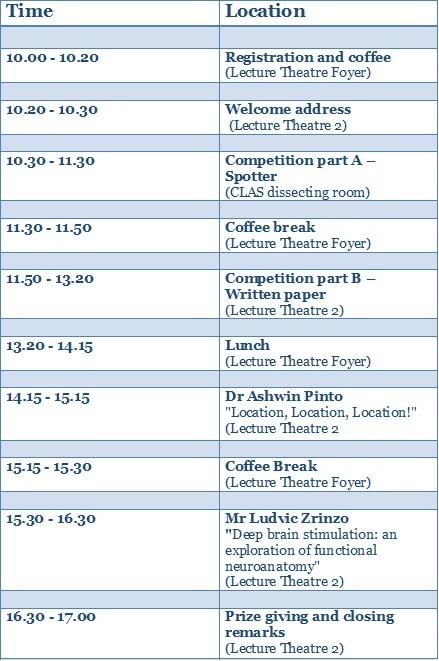
National Undergraduate Neuroanatomy Competition 2013
The 2013 competition was hosted by the University of Southampton and took place on the 23rd March 2013
News following the first NUNC
A group of medical students, in collaboration with the Centre for Learning Anatomical Sciences at Southampton University and the Royal College of Surgeons Edinburgh, have organised the first National Undergraduate Neuroanatomy Competition. Students travelled across the country to partake in the event, which involved two separate examinations and presentations from world-renowned clinicians. The event took over a year of planning and the committee members ranged from senior lecturer level to fourth and third year medical students.
Delegates came from as far as Liverpool, Exeter, London and Cardiff. Preclinical and clinical categories were available for students to enter and the event sold out within three weeks of being advertised. Two fourth year medical students, with assistance from anatomy lecturers and technicians, compiled a highly praised “spotter” examination, which involved them dissecting their own specimens, employing specialist techniques. The multiple choice question examination was written with the aid of several consultant neurosurgeons and included a broad range of questions designed to stretch entrants with exceptional neuroanatomy comprehension. The preclinical medical student winner was Joseph Masters of Barts and the London School of Medicine, and the clinical medical student winner was Milo Hollingworth of University College London. Prizes included several medical textbooks and an eye-catching glass trophy. The runner up prizes were awarded to Fady Atia and Weronika Stupalkowska for clinical and pre-clinical sections respectively.
Dr. Ashwin Pinto directly related neuroanatomy to clinical symptoms in his presentation “Location, Location, Location”. Mr. Ludvic Zrinzo, a neurosurgeon at the National Hospital in London, then inspired students to broaden their neuroanatomical horizons by considering the history of functional neurosurgery, including transorbital lobotomies in the mid 20th century, to modern day techniques of functional neurosurgery. Both speakers interacted with delegates and encouraged discussion on the clinical importance of neuroanatomy.
Following the success of this event the committee has already commenced preparations for next year’s competition. This event is the first of its kind and has the potential to impact the faculty’s profile and reputation, especially with respect to anatomy.
The competition was short-listed for an Enterprise Educator award (2013) in the category of ‘enterprise Champions’
A selection of comments from past competitors
"The specimens were well dissected...this Competition is a highly original format...I'm sure it will go from strength to strength."
"Really good event. Well organised, good facilities/specimens."
"Just wanted to say thank you again to all the organisers for such an interesting and well organised day yesterday."
"Very well organised event, Thank you."
"Very enjoyable day! Thank you"
"...would like to thank you all very much for a wonderful day."

About the Speakers
Mr.Ludvic Zrinzo, Consultant Neurosurgeon
Mr Zrinzo was drawn to neuroanatomy while a medical student and developed this interest during an elective at the Neurosurgical Department in Lund, Sweden, where patients were receiving foetal grafts for Parkinson’s disease. Having completed his undergraduate medical education in Malta, he moved to London to pursue a career in Neurosurgery.
During neurosurgical training, Mr Zrinzo was awarded an MSc in Clinical Neuroscience with Distinction at the UCL Institute of Neurology. He then pursued Stereotactic and Functional Fellowships, at Queen Square, London and at the University of California, Los Angeles (UCLA).
Mr Zrinzo now holds the post of Consultant and Senior Lecturer in Neurosurgery at the National Hospital for Neurology and Neurosurgery and the UCL Institute of Neurology, London. His super-specialty interest is central neuromodulation - in particular, Deep Brain Stimulation (DBS). This surgical technique involves precise surgical targeting of specific neuroanatomical structures to modulate neural activity in pathological networks. The ultimate aim is to improve symptoms and quality of life in patients with chronic neurological conditions. The nuances of functional neuroanatomy are of the utmost importance when caring for and engaging in clinical research with these patients.
Author of over 80 publications and book chapters, Mr Zrinzo was awarded a PhD in Neurosurgery for his work on the use of MR imaging to improve the safety, accuracy and efficacy of DBS surgery in patients. Current research interests include the application of advanced neuroimaging techniques and investigating novel anatomical targets and indications for DBS surgery.
Dr. Ashwin Pinto, Consultant Neurologist
Dr Pinto is a consultant neurologist at the Southampton General Hospital. His university education was conducted at both Cambridge and Oxford universities and was awarded his DPhil for research into Lambert-Eaton Myasthenic Syndrome as part of the Welcome Trust Training Fellowship.
His post-graduate neurology training was at the Radcliffe Hospital, Oxford and the Wessex Neurological Centre in Southampton. His areas of interest are epilepsy, motor neurone disease and myasthenia gravis. In Southampton he has established specialist myasthenia gravis clinics and a plasma exchange service.
He sits on various committees including being the director of the Southampton MND Care Centre, a member of the MND Clinical Studies Group and treasurer of the South of England Neurosciences Association.